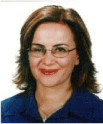The 2020 İzmir earthquake and its effect on COVID-19 cases
Seyfi Durmaz A * , Gönül Aslan B , Raika Durusoy C and Candan Çiçek DA
B
C
D

Seyfi Durmaz is an Associate Professor of Public Health and worked in the Occupational Health and Safety Unit at Ege University Hospital during the pandemic period, actively tracking COVID-19 cases and high-risk contacts among healthcare workers. His research interests include health policy, tobacco control, infectious disease surveillance, occupational health, and medical education. |

Dr Gönül Aslan is a Professor of Microbiology and the Head of the Department at Mersin University Faculty of Medicine. Her areas of interest include tuberculosis and immunology, and she has also served as the regional coordinator for COVID-19 diagnosis. |

Raika Durusoy is a Professor of Public Health at Ege University, and she is the surveillance officer of the university hospital and responsible for the hospital’s occupational health and safety unit, which actively continues to follow up on COVID-19 cases and contacts among the hospital staff since the beginning of the pandemic. Her research interests are communicable disease surveillance, tobacco control and environmental health. |

Candan Çiçek is a Professor of Microbiology and an infectious diseases and clinical microbiology specialist with 30 years of experience in Ege University Medical School at the Department of Clinical Microbiology. Her academic and research interests include diagnostic microbiology, virology and healthcare-related infections. She is currently the President of the Turkish Society for Microbiology. |
Abstract
On 30 October 2020, an earthquake measuring 6.9 moment magnitude occurred between Kusadasi and Samos, Türkiye, with a significant impact on buildings in the Bornova–Bayraklı district of İzmir. Immediately afterwards, a comprehensive study was commenced to investigate the relationship between the earthquake that occurred during the SARS-CoV-2 (COVID-19) pandemic and case numbers at the Ege University, Faculty of Medicine’s Hospital in Bornova, İzmir. This cross-sectional study was carried out based on the records of those admitted to the university hospital with suspicion of COVID-19 in the pre-earthquake and post-earthquake periods of the pandemic. The microbiology laboratory of the hospital used reverse transcription–polymerase chain reaction (RT-PCR) results as a dependent variable and compared with the time, age and gender as the independent variables, classified according to the timing of the earthquake. RT-PCR test results were positive in 11.60% of the whole study group; however, tests were 6.69% positive before the earthquake and increased to 23.42% afterwards (P < 0.001), which equated to an increase of 4.25 times (95% CI 4.04–4.47) when comparing pre- to post-earthquake RT-PCR positivity (P < 0.001). The positive COVID-19 RT-PCR detection rate among those aged 50 and over was greater by a factor of 1.15 (95% CI 1.06–1.23) compared to a younger age group (P < 0.001). There was no difference for the gender variable used in suspected case or contact tracing applications of COVID-19 PCR. However, when stratified by age and gender, in the female group, there was a 1.24-fold (95% CI 1.11–1.38) increase in the 50+ age group (26.2%) compared to the younger age group (22.2%) after the earthquake (P < 0.001). In the male group, the rate of laboratory diagnosis of COVID-19 before the earthquake was in the under-50 age group (7.6%) as compared to the >50 age group (5.2%; P < 0.001).
Keywords: age, COVID-19, earthquake, epidemic curve, epidemiology, gender, İzmir, SARS-CoV-2, Türkiye.
 Seyfi Durmaz is an Associate Professor of Public Health and worked in the Occupational Health and Safety Unit at Ege University Hospital during the pandemic period, actively tracking COVID-19 cases and high-risk contacts among healthcare workers. His research interests include health policy, tobacco control, infectious disease surveillance, occupational health, and medical education. |
 Dr Gönül Aslan is a Professor of Microbiology and the Head of the Department at Mersin University Faculty of Medicine. Her areas of interest include tuberculosis and immunology, and she has also served as the regional coordinator for COVID-19 diagnosis. |
 Raika Durusoy is a Professor of Public Health at Ege University, and she is the surveillance officer of the university hospital and responsible for the hospital’s occupational health and safety unit, which actively continues to follow up on COVID-19 cases and contacts among the hospital staff since the beginning of the pandemic. Her research interests are communicable disease surveillance, tobacco control and environmental health. |
 Candan Çiçek is a Professor of Microbiology and an infectious diseases and clinical microbiology specialist with 30 years of experience in Ege University Medical School at the Department of Clinical Microbiology. Her academic and research interests include diagnostic microbiology, virology and healthcare-related infections. She is currently the President of the Turkish Society for Microbiology. |
References
1 National Earthquake Council (2005) Türkđye Ulusal Deprem Aratirmalari Programi (TUDAP) 2005–2014. [Türkiye National Earthquake Research Programme (TUDAP) 2005–2014.] www.tubitak.gov.tr/tubitak_content_files/ARDEB/kamag/Turkiye_Ulusal_Deprem_Arastirmalari_Programi.pdf (in Turkish, accessed 8 September 2023)
2 Demirci HE et al. (2021) A survey of damage observed in İzmir due to 2020 Samos-İzmir earthquake. Nat Hazards 111, 1047-1064.
| Crossref | Google Scholar |
3 Dünya Doktorları Derneği (2020) İzmir earthquake rapid assessment report. November 2020. https://www.dunyadoktorlari.org.tr/media/pages/medya/yayinlar/izmir-earthquake-rapid-assessment-report-november-2020/dadb5d58d9-1631865649/ddd-izmir-earthquake-assessment-report.pdf (accessed 29 September 2023)
4 İzmir Medical Chamber (2020) İzmir Depremi Birinci Ay Değerlendirme Raporu. [İzmir earthquake rapid assessment report.] In İzmir Tabip Odası, 8 December 2020. https://www.izmirtabip.org.tr/news/4832 (in Turkish, accessed 8 September 2023)
5 Republic of Türkiye’s Ministry of Health (2020) Contact tracking, epidemic management, patient monitoring at home and filiation. https://covid19.saglik.gov.tr/TR-66339/temasli-takibi-salgin-yonetimi-evde-hasta-izlemi-ve-filyasyon.html (accessed 29 September 2023)
6 Uçar A et al. (2020) An interactive and real-time web application for monitoring of COVID-19 pandemic in Türkiye: TURCOVID19. Anadolu Clin 25, 154-155.
| Crossref | Google Scholar |
7 Robinson B et al. (2011) Natural disasters and the lung. Respirology 16, 386-395.
| Crossref | Google Scholar |
8 Kouadio IK et al. (2012) Infectious diseases following natural disasters: prevention and control measures. Expert Rev Anti Infect Ther 10, 95-104.
| Crossref | Google Scholar | PubMed |
9 Turkish Medical Association (2020) İzmir earthquake first month preliminary evaluation report, 01.12.2020. https://www.ttb.org.tr/905yic0 (in Turkish, accessed 1 September 2023)
10 Balbay Ö et al. (2011) The effects of two sequential earthquakes on tuberculosis patients: an experience from Düzce earthquake. HealthMED 5, 589-595.
| Google Scholar |


